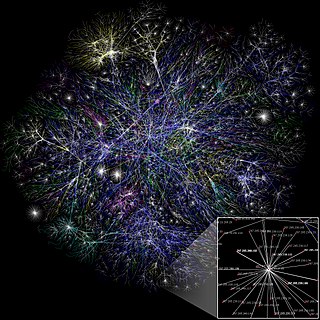 W
WIn the field of psychology, cognitive dissonance is the perception of contradictory information. Relevant items of information include a person's actions, feelings, ideas, beliefs, and values, and things in the environment. Cognitive dissonance is typically experienced as psychological stress when persons participate in an action that goes against one or more of those things. According to this theory, when two actions or ideas are not psychologically consistent with each other, people do all in their power to change them until they become consistent. The discomfort is triggered by the person's belief clashing with new information perceived, wherein the individual tries to find a way to resolve the contradiction to reduce his or her discomfort.
 W
WA communication theory is a proposed description of communication phenomena, the relationships among them, a storyline describing these relationships, and an argument for these three elements. Communication theory provides a way of talking about and analyzing key events, processes, and commitments that together form communication. Theory can be seen as a way to map the world and make it navigable; communication theory gives us tools to answer empirical, conceptual, or practical communication questions.
 W
WCultivation theory is a sociological and communications framework to examine the lasting effects of media, primarily television. It suggests that people who are regularly exposed to media for long periods of time are more likely to perceive the world's social realities as they are presented by the media they consume, which in turn affects their attitudes and behaviors.
 W
WDecoding Communication is a book on theories and modern practice of communication by N. Chandramouli published by TRA publishing in 2012. It elaborates on "Communication Fundamentals", "Models of Communication" and studies the "Future through Communication". It draws on several theories including concepts of meme from Richard Dawkins 1976 book The Selfish Gene, the book builds on theories of Brand Trust, Brand Appeal, Perception and Propaganda. The books applies concepts of conservation to communication showing the importance of Sustainable Communication to the future of mankind. Chandramouli is also the author of The Brand Trust Report, India's Most Attractive Brands and India's Most Reputed Brands. The phrase "decoding communication" can be academically explained as the process of turning communication into thoughts.
 W
WDiscourse Studies is a bimonthly peer-reviewed academic journal that covers the field of discourse analysis, especially articles that offer a detailed, systematic and explicit analysis of the structures and strategies of text and talk, their cognitive basis and their social, political and cultural functions. It specifically also publishes studies in conversation analysis. The journal was established in 1999 by Teun A. van Dijk.
 W
WEgalitarian dialogue is a dialogue in which contributions are considered according to the validity of their reasoning, instead of according to the status or position of power of those who make them. Although previously used widely in the social sciences and in reference to the Bakhtinian philosophy of dialogue, it was first systematically applied to dialogical education by Ramón Flecha in his 2000 work Sharing Words. Theory and Practice of Dialogic Learning.
 W
WFace-Negotiation Theory is a theory conceived by Stella Ting-Toomey in 1985, to understand how people from different cultures manage rapport and disagreements. The theory posited "face", or self-image when communicating with others, as a universal phenomenon that pervades across cultures. In conflicts, one's face is threatened; and thus the person tends to save or restore his or her face. This set of communicative behaviors, according to the theory, is called "facework". Since people frame the situated meaning of "face" and enact "facework" differently from one culture to the next, the theory poses a cultural-general framework to examine facework negotiation. It is important to note that the definition of face varies depending on the people and their culture and the same can be said for the proficiency of facework.
 W
WMiscommunication is defined as a failure to communicate adequately and properly. It is one of the types of Communication barrier.
 W
WModels of communication are conceptual models used to explain the human communication process. The first major model for communication was developed in 1948 by Claude Shannon and published with an introduction by Warren Weaver for Bell Laboratories. Following the basic concept, communication is the process of sending and receiving messages or transferring information from one part (sender) to another (receiver).
 W
WMonopolies of knowledge arise when the ruling class maintains political power through control of key communications technologies. The Canadian economic historian Harold Innis developed the concept of monopolies of knowledge in his later writings on communications theories.
 W
WThe organon model, formulated by German psychologist and linguist Karl Ludwig Bühler, defined the functions of communication according to which linguistic communication can be described. Bühler's work influenced Roman Jakobson for his communication model.
 W
WSocial comparison theory, initially proposed by social psychologist Leon Festinger in 1954, centers on the belief that there is a drive within individuals to gain accurate self-evaluations. The theory explains how individuals evaluate their own opinions and abilities by comparing themselves to others in order to reduce uncertainty in these domains, and learn how to define the self.
 W
WSocial constructionism is a theory of knowledge in sociology and communication theory that examines the development of jointly-constructed understandings of the world that form the basis for shared assumptions about reality. The theory centers on the notion that meanings are developed in coordination with others rather than separately within each individual. It has often been characterised as neo-Marxian or also as a neo-Kantian theory, in that social constructionism replaces the transcendental subject with a concept of society that is at the same time descriptive and normative.
 W
WSocial information processing theory, also known as SIP, is an interpersonal communication theory and media studies theory developed in 1992 by Joseph Walther. Social information processing theory explains online interpersonal communication without nonverbal cues and how people develop and manage relationships in a computer-mediated environment. Walther argued that online interpersonal relationships may demonstrate the same or even greater relational dimensions and qualities (intimacy) as traditional FtF relationships. However, due to the limited channel and information, it may take longer to achieve than FtF relationships. These online relationships may help facilitate interactions that would not have occurred face-to-face due to factors such as geography and intergroup anxiety.
 W
WA social network is a social structure made up of a set of social actors, sets of dyadic ties, and other social interactions between actors. The social network perspective provides a set of methods for analyzing the structure of whole social entities as well as a variety of theories explaining the patterns observed in these structures. The study of these structures uses social network analysis to identify local and global patterns, locate influential entities, and examine network dynamics.
 W
WSocial support is the perception and actuality that one is cared for, has assistance available from other people, and most popularly, that one is part of a supportive social network. These supportive resources can be emotional, informational, or companionship ; tangible or intangible. Social support can be measured as the perception that one has assistance available, the actual received assistance, or the degree to which a person is integrated in a social network. Support can come from many sources, such as family, friends, pets, neighbors, coworkers, organizations, etc.